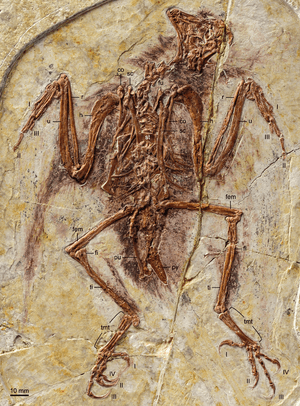Enantiornithes facts for kids
Quick facts for kids Enantiornitheans |
|
|---|---|
 |
|
| Fossil specimen of a bohaiornithid (Zhouornis hani) | |
| Scientific classification |
|
| Kingdom: | Animalia |
| Phylum: | Chordata |
| Clade: | Ornithothoraces |
| Clade: | †Enantiornithes Walker, 1981 |
| Subgroups | |
|
|
Enantiornithes were a group of ancient, extinct birds. They lived a long, long time ago during the Mesozoic Era. These birds were very common and diverse. They looked a lot like modern birds, but most had teeth and claws on their wings! Over 80 different kinds of Enantiornithes have been found. They all died out at the end of the Cretaceous period. This was the same time all other non-bird dinosaurs disappeared.
Contents
About Enantiornithes
Enantiornithes were a very successful group of early birds. They lived during the Cretaceous period, which was part of the Mesozoic Era. This era is sometimes called the "Age of Dinosaurs."
Most Enantiornithes had teeth in their beaks. They also had small claws on their wings. Despite these differences, they looked quite similar to the birds we see today.
What's in a Name?
The name "Enantiornithes" means "opposite birds." It comes from two ancient Greek words: enantios (meaning "opposite") and ornithes (meaning "birds").
A scientist named Cyril Alexander Walker gave them this name in 1981. He noticed something special about their shoulder bones. The way their scapula (shoulder blade) and coracoid (another shoulder bone) fit together was the opposite of modern birds. This unique joint helped scientists identify them.
When Did They Live?
Enantiornithes lived from the Early Cretaceous to the Late Cretaceous periods. This means they were around for millions of years. They were the most common and varied group of birds during the Mesozoic Era.
What Happened to Them?
Like many other ancient creatures, Enantiornithes became extinct. They died out at the end of the Cretaceous period. This event is known as the Cretaceous–Paleogene boundary (K-Pg boundary).
This was a huge extinction event. It wiped out all the non-bird dinosaurs. Other bird groups, like the hesperornithids, also disappeared. Scientists believe that Enantiornithes left no living relatives.
Images for kids
See also
 In Spanish: Enantiornitas para niños
In Spanish: Enantiornitas para niños






